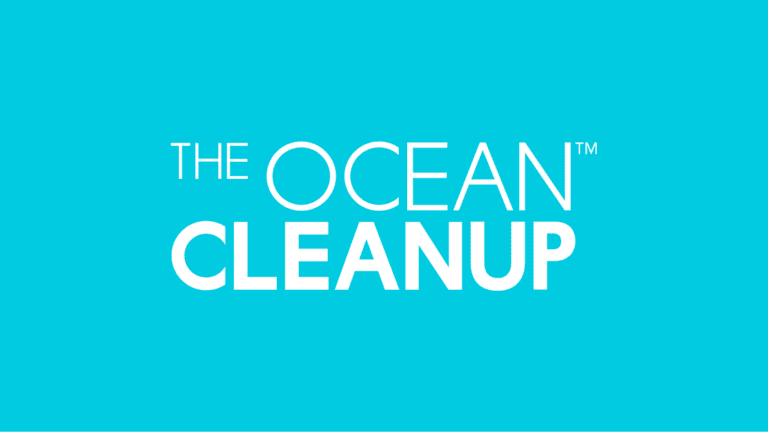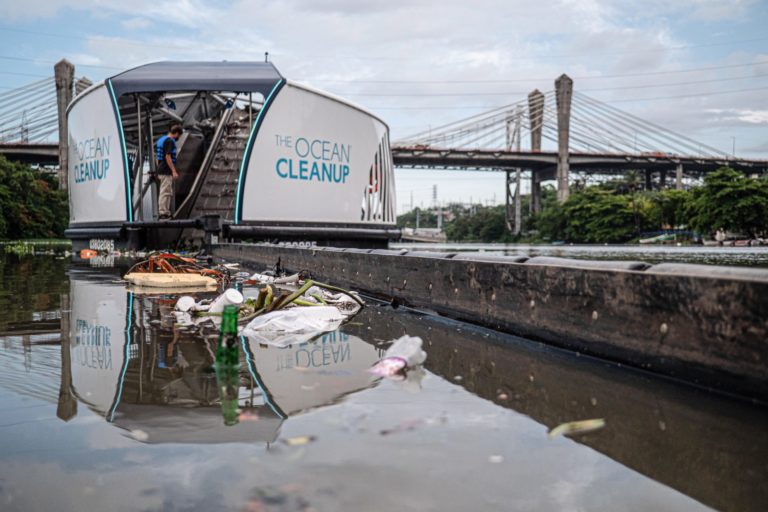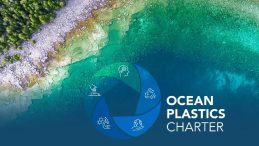Let’s take a look at some of the amazing initiatives that are currently helping to tackle the plastic problem in our oceans and waterways.
- The Ocean Cleanup

The Ocean Cleanup is a non profit that was founded by Boyan Slat in 2013, when Slat was just 18. The Ocean Cleanup projects to be able to remove 90% of floating ocean plastic by 2040, their main focus is cleaning up the ocean’s garbage patches with energy efficient solutions.
Their current system is called System 002 aka Jenny. Jenny is a floating barrier that is 800m long and 3 meters deep, but is open at the bottom which means marine life doesn’t get trapped. Jenny’s “wings” are connected to two vessels which creates a U shape, the vessels tow Jenny at less than 2mph creating a natural flow of water. The plastic travels along the current and eventually ends up in a central collection area called ‘the retention zone’. When it comes to collecting the plastic, one of the vessels hands its wing to the other and then heads to the retention zone to pull in the catch. The debris is sorted and then sent to shore to be recycled or disposed of in the correct manner. This July Jenny completed a successful 12 week test campaign located at the Great Pacific Garbage Patch. Jenny made 9 extractions in these 12 weeks, with one extraction netting nearly 20,000 pounds of debris.


During operations in 2019 when The Ocean Cleanup was using their older model, System 001/B, aka Wilson, they manufactured high end sunglasses made entirely from recycled plastic from the Great Pacific Garbage Patch! You can still buy these from their website and 100% of the proceeds go directly back to the continuing clean up operations. They are not currently doing this with System 002 because The Ocean Cleanup doesn’t want to get into the manufacturing business, the sunglasses were made to prove that a circular economy is possible and that we can ‘turn our trash into something truly valuable’. Going forward, The Ocean Cleanup will be working with consumer companies to integrate its material into their sustainable products, allowing them to focus on the clean up side of things.
Whilst System 002 continues its amazing work in the Great Pacific Garbage Patch, System 003 is already being developed. System 003 aims to be three times as big as System 002, increasing the ability to collect more plastic. Watch this space!


If you needed any more convincing about The Ocean Cleanup, they also have a side project that is stopping ocean plastic at the source. Rivers are the main source of ocean plastic pollution and so ‘The Interceptor’ was created. The Interceptor is a fully autonomous, 100% solar powered system that has a Catamaran like design which is anchored to riverbeds. It is strategically placed in rivers ensuring that the main plastic flow is intercepted. It does this by making use of the natural flow of the water and using a barrier which guides the plastic to the mouth of the vessel onto a conveyor belt. This scoops the waste out of the water, into the belly of The Interceptor and drops it into dumpsters. The Interceptor can extract 50,000 kg of trash a day (although in the right conditions it’s thought that this could be doubled!). It has an on board computer which is connected to the internet allowing it to be monitored 24/7. When the shuttles are full The Interceptor will send a text message to the local operators who will then come and collect the waste, sending it off to local waste management facilities. Even when the dumpsters are being emptied The Interceptor can continue extracting debris.


There are currently four interceptors around the globe with further agreements taking place. The Ocean Cleanup has found that 1000 rivers are responsible for roughly 80% of riverine pollution and their goal is to tackle these 1000 rivers in just 5 years!
- Seabin Project


Seabin Pty Ltd was launched in 2015 with the idea that if there were rubbish bins on land, why not in the water? Overtime this idea has evolved into the Seabin V5.The Seabin V5 is a ‘trash skimmer’ designed to be installed in a calm body of water such as Marinas, Ports and Yacht Clubs where it is installed on a floating pontoon so it can be maintained by staff. It is basically a floating trash can, made from recyclable material, which skims the surface of the water. Water is sucked in from the surface and passes through a catch bag inside the Seabin, to do this it uses a pump which needs to be plugged into an outlet- hence why Marinas are a great location. Even though it needs power to run it only costs around $3 a day. The Seabin can intercept plastic, microplastics (down to 2mm small) and even microfibres. It can even be equipped with oil absorbent pads which can absorb petroleum based surface oil and detergent which is super useful in marina and ports! The water is then pumped back into the ocean leaving the various debris and litter items in the catch bag. These bags can hold up to 20kg of debris. With 860 Seabins worldwide that’s a lot of trash being removed from the ocean, 3612.8kgs a day in fact!


So what happens to all the material that is collected? Everyone who purchases a Seabin V5 is encouraged to recycle what plastics they can, but the team at Seabin Project are working on creating a recycling program for Seabin clients, they love the idea of the captured plastics being part of a circular economy, or at the very least not being sent to landfill.
- WasteShark


The WasteShark is a product by Ranmarine Technologies who specialise in the design and development of industrial autonomous surface vessels (ASV’s) for ports, harbours and other marine and water environments; think your local lake or river. The WasteShark is designed to remove floating pollution such as plastics, micro plastics (to 3mm) algae and biomass from lakes, ponds, waterways and harbours. The WasteShark is actually modelled on the whale shark and has a Catamaran like design which allows waste to simply float into the mouth of the waste shark. It can be operated either manually via an onshore hand held device or autonomously with online control, using GPS routes to navigate the desired areas. There is an option to add LiDAR to the device (light detection and ranging), a radar system that uses light from a laser rather than radio waves. This helps reduce collisions and enhances data captured from the environment.
It has a maximum storage capacity of 160 litres (42 gallons), a cruising speed of 3km per hour and a battery life of 8hrs which can simply be recharged at home. Because of these specs it’s very unobtrusive in the water and it realises zero carbon emissions.
Like the Seabin, the onus here is on the user to dispose of the waste appropriately.


We might not all be entrepreneurs or inventors but there are still things that we can do to help clean up our oceans.
1. Spread The Message
Let others know about these amazing inventions, knowledge is power! The more people are aware of the incredible things happening in the fight against plastic pollution the more support they will have to continue fighting for cleaner oceans and waterways. Products like the Seabin and WasteShark can be used locally, with your help you might have the chance to influence change and get one of these products in your area. Go down to your nearest Marina or speak to your local representative and see if they have thought about implementing these products. Chances are because this is still a relatively new market, these products might not have even been heard of, let alone given the chance to be considered.
2. Donate
Charities need donations in order to run. Every little helps. The Ocean Cleanup raised initial funds via Crowdfunding in 2014 and now look at what they are aiming to achieve. Whether you are an individual or a company, donating any amount to a registered charity, like Plastic Oceans Canada, can make a huge difference to the fight against plastic pollution.
3. Volunteer
Volunteering is an amazing way to help our plastic pollution. There are so many different ways to volunteer, for example take part in a classic beach clean up or create a local fundraising event to raise money for your preferred charity.
4. Use Less Plastic
Of course this list wouldn’t be complete without stating the obvious. There are so many companies out there that are joining the fight against plastic pollution; online grocery stores that deliver your food plastic free, some will even come back to collect the cardboard packaging to reuse it. There are companies that deliver toilet rolls to your door that are made from sustainable bamboo, packaged in paper not plastic! There are sustainable fashion brands that are clamping down on greenhouse emissions and creating ocean friendly items from materials that produce less microfibres in the wash. There are so many ways to reduce the plastic we use, we just need to take a moment to find them.
It seems that there is hope in the fight against plastic pollution in our waters but even though these incredible inventions exist, they shouldn’t be solely relied upon. We need to stop plastic pollution at the source and do everything we can to stop it from entering our waterways in the first place.
